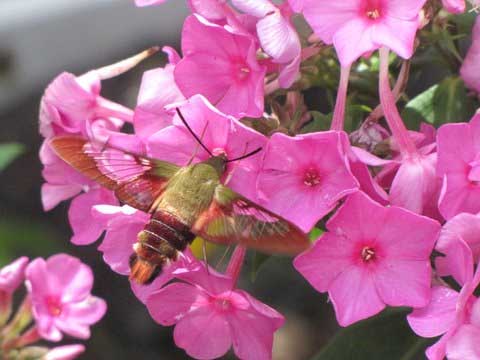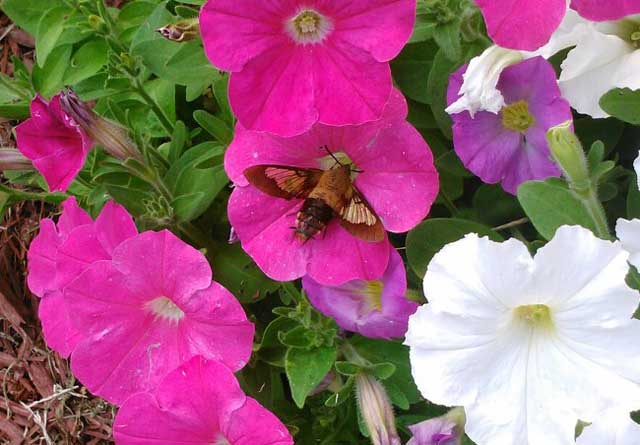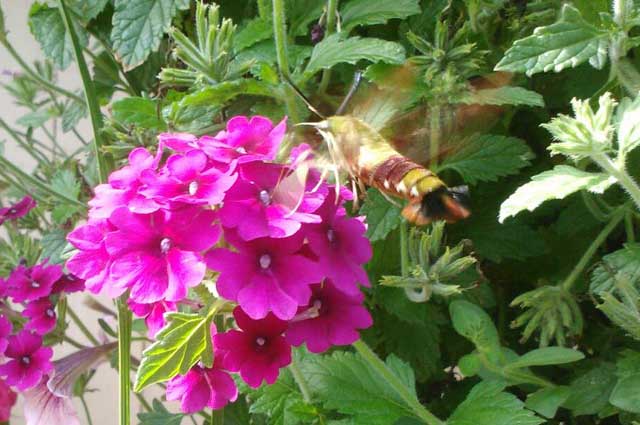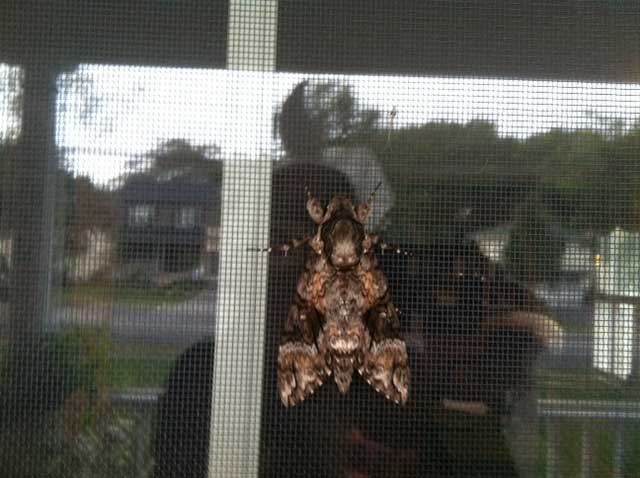Monmouth County, New Jersey
Sphingidae
Hemaris thysbe, Port Monmouth, Monmouth County, New Jersey,
July 4, 2011, courtesy of Vic Godley, via Michael Godley.
|
|
Updated as per James P. Tuttle's The Hawk Moths of North America, September 5, 2010 Updated as per Matawan, Monmouth County, New Jersey, September 5, 2010, Eumorpha fasciatus sighting on Bug Guide; September 5, 2010 Dedicated as per personal communication with Vic Godley and his son, Michael Godley, July 4, 2011 Updated as per personal communication with Amy Hemming (Hemaris thysbe; Marlboro, August 17-18, 2012); August 18, 2012 Updated as per personal communication with Colleen Donovan (Agrius cingulata, Long Branch, October 7, 2012); October 9, 2012 |

Hemaris thysbe, Port Monmouth, Monmouth County, New Jersey,
July 4, 2011, courtesy of Vic Godley, via Michael Godley.
This page is dedicated to Vic Godley and Michael Godley. Michael sent me the picture of Hemaris thysbe top of the page.
The image was taken by his father Vic Godley in Port Monmouth, Monmouth County, New Jersey,
July 4, 2011. Permission was granted to post the image.
Michael writes, "My father Victor Godley in Port Monmouth NJ, Monmouth County found this guy feeding from a Phlox plant in his yard on July 4th 2011.
This was the only photo that came out good.
"My father has lived in this area for over 60 years and cannot recall ever seeing this creature. I live in the Philadelphia Suburbs and have never seen one.
Are they common in my Dad's area?"
I reply, "That one is Hemaris thysbe, the Hummingbird Clearwing Moth.
My Monmouth County Sphingidae pictoral checklist is at
http://www.silkmoths.bizland.com/njMonmouthsph.htm.
I grew up in Hunterdon County.
"The moth is quite common in at least the eastern two-thirds of North America.
We have them here on PEI also.
"I request your father`s permission to post image, credited to him, on the Monmouth County page.
There are three clearwing species that fly in your area."
This site has been created by
Bill Oehlke at oehlkew@islandtelecom.com
Comments, suggestions and/or additional information/sightings are welcomed by Bill.
Forty-four Sphingidae species are listed for New Jersey on the U.S.G.S. website. Not all of the species are reported or anticipated in Monmouth County (twenty-seven are reported on U.S.G.S. as of August 5, 2010). It is hoped that this checklist, with the thumbnails and notes, will help you quickly identify the moths you are likely to encounter.
A "WO" after the species name indicates that I (William Oehlke) expect that this moth is present or might be present, although unreported. I have added quite a few species that I feel are likely present although unconfirmed.
Please help me develop this list with improved, documented accuracy by sending sightings (species, date, location), preferably with an electronic image, via email to Bill Oehlke.
Many thanks also to Amy Hemming who sends the following images from Marlboro:

Hemaris thysbe, Marlboro, Monmouth County, New Jersey,
August 17, 2012, courtesy of Amy Hemming.

Hemaris thysbe, Marlboro, Monmouth County, New Jersey,
August 18, 2012, courtesy of Amy Hemming.

Agrius cingulata, Long Branch, Monmouth County, New Jersey,
october 7, 2012, courtesy of Colleen Donovan, id by Bill Oehlke.
Visit Monmouth County Sphingidae Larvae: Caterpillars; Hornworms
Visit New Jersey Catocala: Underwing Moths
If you are travelling, you can find active Sphingidae checklists for all countries in North, Central, and South America and the Caribbbean via the links at
North, Central, South American Sphingidae checklists
Sphinginae subfamily
Smerinthini Tribe:
Macroglossinae subfamilyDilophonotini tribe:
See Hemaris comparison to help distinguish the next three species.
Hemaris thysbe, Marlboro, August 17-18, 2012, Amy Hemming.
Philampelini tribe:
Macroglossini tribe:
|
Enjoy some of nature's wonderments, giant silk moth cocoons. These cocoons are for sale winter and fall. Beautiful Saturniidae moths will emerge the following spring and summer. Read Actias luna rearing article. Additional online help available.
Use your browser "Back" button to return to the previous page.
This page is brought to you by Bill Oehlke and the WLSS. Pages are on space rented from Bizland. If you would like to become a "Patron of the Sphingidae Site", contact Bill.
Please send sightings/images to Bill. I will do my best to respond to requests for identification help.
 Show appreciation for this site by clicking on flashing butterfly to the left. The link will take you to a page with links to many insect sites. |
I very much appreciate all the many images that have been sent to me, or of which I have been granted permission to copy and post from other websites. All images on this site remain the property of respective photographers.
If you would like to contribute to the maintenace of this website by sending a contribution to
Bill Oehlke
Box 476
155 Peardon Road
Montague, Prince Edward Island, C0A1R0
Canada
your donation would be much appreciated and would be used for
1) paying for webspace rental;
2) paying for computer maintenance and software upgrades;
3) purchases of additional text reference material (journals and books) in anticipation of expanding the site to a worldwide Sphingidae site;
4) helping to pay my daughter's tuition (completed spring 2013); with anything left over going to humanitarian aid.
If you are mailing a check from USA, please use $0.85 postage. ($1.15 is 2014 rate so check with post office as rates seem to be rising almost annually.) Donations can also be made through Paypal via the button below.